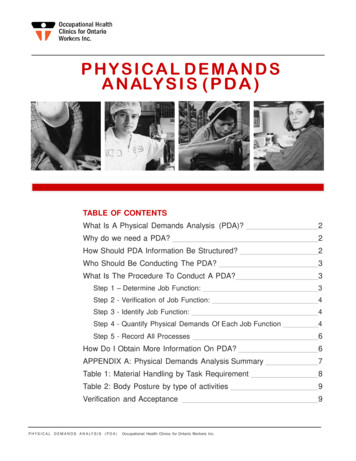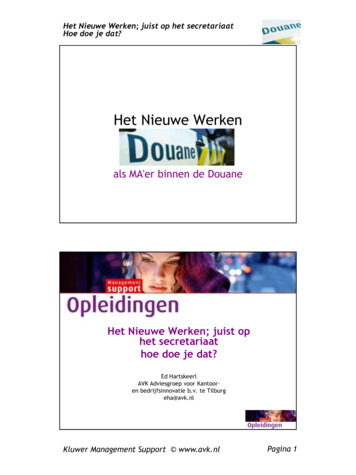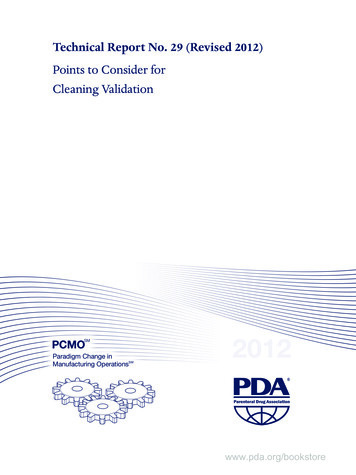
Transcription
PHYSICAL DEMANDSA N ALY S I S ( P D A )TABLE OF CONTENTSWhat Is A Physical Demands Analysis (PDA)?2Why do we need a PDA?2How Should PDA Information Be Structured?2Who Should Be Conducting The PDA?3What Is The Procedure To Conduct A PDA?3Step 1 – Determine Job Function:3Step 2 - Verification of Job Function:4Step 3 - Identify Job Function:4Step 4 - Quantify Physical Demands Of Each Job Function4Step 5 - Record All Processes6How Do I Obtain More Information On PDA?6APPENDIX A: Physical Demands Analysis Summary7Table 1: Material Handling by Task Requirement8Table 2: Body Posture by type of activities9Verification and Acceptance9P H Y S I C A L D E M A N D S A N A LY S I S ( P D A )Occupational Health Clinics for Ontario Workers Inc.
P H Y S I C A L D E M A N D S A N A LY S I S ( P D A )WHAT IS A PHYSICAL DEMANDS ANALYSIS (PDA)?A Physical Demands Analysis is a systematic procedure to quantify, and evaluateall of the physical and environmental demand components of all essential and nonessential tasks of a job. PDA is a process of establishing what a job is in itsentirety in a way that complies with the Ontario Human Rights Code. A PDA isthe “cornerstone” of the analytical process used to determine compatibilitybetween a worker and a specific job.WHY DO WE NEED A PDA?With the recent passing of Bill 99 (Workplace Safety and Insurance Act, 1997),the Workplace Safety and Insurance Board (WSIB) has the right to requestinformation about an injured worker’s functional abilities from a treating healthprofessional (Sec. 37.3). The required information must be provided on aprescribed form distributed by WSIB. The purpose of obtaining an injured worker’sfunctional abilities is for “facilitating the worker’s timely return to work”.One of the primary goals of a Functional Ability Evaluation (FAE) is to match aninjured worker’s work capability to a job or task, without causing an overexertioninjury. If the functional abilities of an injured worker are used to assess whether aworker can return to work (RTW), a PDA describing the job should also bedeveloped. Without any information about the physical demands of a job's essentialand nonessential duties, the functional ability information is not useful.HOW SHOULD PDA INFORMATION BE STRUCTURED?There are many ways in which physical demands of a job can be structured. Youmay already have a PDA form in your workplace. OHCOW suggests the use ofthe PDA structure outlined in Appendix A.Regardless of t h e t y p e of s t r u c t u r e , all PDA forms should have briefinformation about the job, a list of all essential and non-essential duties, and allactivities associated w i t h each duty. When PDA information is used for thepurposes of returning to work, it should have the following objectives: Ability to document a job in a non-discriminator y manner; Comply with Ontario Human Rights Code (OHRC) – identify the essential andnon-essential job functions, describe the work, and document the physicalrequirements of the job and the worksite; Use “objective” measurements to determine what is the standardP H Y S I C A L D E M A N D S A N A LY S I S ( P D A )Occupational Health Clinics for Ontario Workers Inc.2
P H Y S I C A L D E M A N D S A N A LY S I S ( P D A ) Able to assist the injured worker to return to their previous job by identifyingspecific job tasks that are within the worker’s working Develop restricted duties or modified work programs from the physical Provideunion representatives and employersreasonable accommodations for injured workers;with informationabout Identify safety concerns, engineering and administrative improvements.WHO SHOULD BE CONDUCTING THE PDA?A PDA should be conducted jointly by a worker and employer representativeknowledgeable about PDA information. If an external consultant conducts the PDA,the worker and employer representatives should sign-off on the PDA information toindicate the accuracy and completeness of the consultant’s analysis.WHAT IS THE PROCEDURE TO CONDUCT A PDA?A PDA is a process of breaking up a job in order to examine its individual tasks.When conducting a physical demand analysis, investigators will objectively quantifyand evaluate the environmental conditions, use of machines, equipment, tools,work aids, and physical demands of each task. To quantify the physical andenvironmental demands of the job, direct and indirect observation techniques areutilized.The following is a general step-by-step discussion of the five components of thePDA Process.STEP 1 – DETERMINE JOB FUNCTION:Worker and employer investigators meet to discuss the existing information of thejob title and job description. In most cases, there will already be a narrative jobdescription.Reviewing the existing job description, investigators should determine: If the job information is current; The purpose or intent of the position; Identify all different components of the job (i.e. all related tasks); and All essential and non-essential functions.P H Y S I C A L D E M A N D S A N A LY S I S ( P D A )Occupational Health Clinics for Ontario Workers Inc.3
P H Y S I C A L D E M A N D S A N A LY S I S ( P D A )STEP 2 - VERIFICATION OF JOB FUNCTION:This process verifies that the duties and tasks outlined by the job description areactually performed in the job being analysed. The common work areas where thenormal performance of the duties takes place must also be verified. Job analystsshould obtain a clear understanding of the flow of the work going into and out ofthe workstation being analysed, and identify the relationship of the position beinganalysed to other positions in the department.STEP 3 - IDENTIFY JOB FUNCTION:The third component of the PDA process is to identify or break down whatfunctions of the job are essential and non-essential. Next, the investigatorsshould determine as objectively as possible the various tasks, subtasks orfunctional components of the job/position. After determining the various tasks,subtasks, or functional components of the job/position, the investigators shouldquantify the duration of each task/subtask by: Timing the time spent per forming each function using a stop watch; Calculating the percentage of time per day, week, or shift spent on varioustasks; or Counting the cycles or repetitions of functions being per formed.STEP 4 - QUANTIFY PHYSICAL DEMANDS OF EACH JOB FUNCTIONThe fourth component of the job analysis process is to objectively quantify thephysical and environmental requirements for each task/duty. In order toobjectively measure the intensity, frequency, and duration of physical functions,the following measuring instrument should be used: weight scale tape measure push-pull gauge grip and pinch force gauge video camcorder stop watch other measurement devices specific to the workplace (i.e. vibration instruments)P H Y S I C A L D E M A N D S A N A LY S I S ( P D A )Occupational Health Clinics for Ontario Workers Inc.4
P H Y S I C A L D E M A N D S A N A LY S I S ( P D A )The physical elements to quantify for each task can include the followingactivities:1. mobility (walking, sitting, standing, crouching, stooping, climbing, balancing,crawling, and kneeling);2. manual material handling (lifting, pushing, pulling, and carr ying);3. reaching (vertical and horizontal work);4. handling;5. fingering; and6. propioception (feeling, seeing, taste/smell, talking and hearing).For each essential and nonessential duty, the investigators should determine if anyof the physical elements are required to perform the task. If physical demandsare required to perform a task, objective quantification of the intensity,frequency, and duration of each physical function should be recorded.For example, in Appendix A, a PDA sheet is shown. The job title in this example isa Meterman/Learner job. The purpose of this job is to learn the correct procedure toclean and change residential and industrial meters. The job consists of threeessential functions and two non-essential duties. Observing Table 1 (Materialhandling by task requirement), you will notice that essential task #1 is required tobe per formed for 60% of the shift. The physical demands for this task are lifting,carrying, reaching, handling, and fingering. The frequency, intensity, and variouswork parameters are outlined on the second column.For essential task #2, the physical demands consist of lifting, pushing, pulling,reaching, handling, and fingering. The duration of essential task #2 is 20% ofthe shift. The frequency, intensity, and various work parameters are outlined onthe third column.From these two examples, you will notice that many tasks do not require theinvestigators to quantify all physical demands. However, if the investigatorsobserved that a physical demand is required in order to perform the task/duty,quantification of all work parameters associated with the physical demand shouldbe performed.P H Y S I C A L D E M A N D S A N A LY S I S ( P D A )Occupational Health Clinics for Ontario Workers Inc.5
P H Y S I C A L D E M A N D S A N A LY S I S ( P D A )STEP 5 - RECORD ALL PROCESSESOnce all physical demands of each task are quantified, the following processshould be followed:1) Enter the PDA data into a spreadsheet or word processor and create theinitial report including the identification of all essential and nonessential functionsof the job (see Appendix A for examples).2) Submit an initial report to the Employer and Union representatives for reviewand sign-off.3) The Employer and Union representatives return the initial report with anymodifications/corrections in regard to the essential and nonessential functionof the job.4) difications/corrections.5) The final report should be signed-off by worker and employer representatives,to indicate the accuracy of the physical demands analysis of the job.HOW DO I OBTAIN MORE INFORMATION ON PDA?OHCOW has developed a detailed guideline to perform PDAs. If you like toobtain more information in this area, please contact the Occupational HealthClinics for Ontario Workers Inc. You can also request for information through ourweb page, www.ohcow.on.ca.P H Y S I C A L D E M A N D S A N A LY S I S ( P D A )Occupational Health Clinics for Ontario Workers Inc.6
P H Y S I C A L D E M A N D S A N A LY S I S ( P D A )APPENDIX A: PHYSICAL DEMANDS ANALYSIS SUMMARYEmployer:Dept/Div: Meter DepartmentLocation: Toronto, ONJob Contact:Job Title: Meterman/LearnerEffective Date: 01/01/9Plant: DowntownWork Hours/Shifts:The average week is 40 hours, Monday to Friday. Meterman/Learner are assignedto work either one of two shifts, either 8am to 4pm or 8am to 6pm. Two 10 minutebreaks and one 20-minute lunch are provided per shift.Job Purpose:Learning to clean and change residential and industrial meters.Essential Functions:1. Dissemble and re-assemble meters to clean moving parts using pliers, brush,screwdriver, and air tool.2. Dissemble damaged meters, current and potential transformers to scrapindividual parts using wrench, and screwdriver.3. Mount current transformer to coil plate using wrench, screwdriver, and power tool.Non-Essential Functions:1. Perform housekeeping duties such as dusting, working with ladders etc.2. Transport materials from basement using skid.General Observations:Meterman/Learner will be trained and become qualified in all aspects of shop andfield work for the duration of approximately 6-8 months. A Meterman/Learner isexpected to be able to clean a minimum of 16 meters per shift within 6 monthsof employment. The work is self-paced, but production volume for the day must bemet. Once every 3-4 weeks, a Meterman/Learner will be expected to work from8am to 6pm. On that week, the Meterman/Learner will work 4 days per week.Most work areas have good lighting. On days in which work is performed outside,Meterman/Learner will be exposed to a variety of temperatures and weatherconditions. These working conditions will vary, depending on the seasonal climate.The most significant physical demand is the potential to handle 100 lbtransformers, and frequent standing. On heavy manual material handling tasks,teamwork (2-3 co-workers) will be provided.P H Y S I C A L D E M A N D S A N A LY S I S ( P D A )Occupational Health Clinics for Ontario Workers Inc.7
P H Y S I C A L D E M A N D S A N A LY S I S ( P D A )TABLE 1: MATERIAL HANDLING BY TASK REQUIREMENTManual Material Handling ActivitiesEss. Task 1(60%/shift)Ess. Task 2(20%/shift)Ess. Task 3(5%/shift)Noness.Task 1Noness.Task 26-40"6-34"6-32 lb0.049-34"9-36"6-50 lb0.0136"55"20-80 lb(1-2/month)18-20"17-20"38-50 lbOccasional30-35"71-75"20-35 lb0.01Lifting:Beginning Heights(in)Ending Heights(in)Weights (lbs)Frequency(#/min)Carrying: Weight(lbs) Distance(in)Frequency(#/min)6-32 lb9600.03Pushing:30-33"45-60 lb(1-2/week)Push Heights(in)Horizontal Force(lbs)Frequency(#/min)Pulling:Pull Heights(in)Horizontal Force(lbs)Frequency(#/min)Reaching ( 10 lb):Front Distance(in)Vertical Height(in)Reach DirectionFrequency(%/shift)20-80 lb20-25"(5-10/month)34-46"30-40 lb(1/day)34-46"30-40 lb(1/day)30-33"45-60 t9.936"Front1.53-8 lb4-7"9.83-35 lb40-50 lb2-7"4.646-10 lb30-50 lb2-6"1.64-6 lb4-6 lb6-15 kbkey, 3-ptkey, 3-pt32.35.51-4 lb10-15 lb2 ptX1.8Handling:Weight of Object(lbs)Grip Weight of Object(lbs)Pinch Force(lb)Pinch TypeFinger Flexion (x)Frequency(%/shift)Ess Essential Task; Noness Non-essential taskP H Y S I C A L D E M A N D S A N A LY S I S ( P D A )Occupational Health Clinics for Ontario Workers Inc.8
P H Y S I C A L D E M A N D S A N A LY S I S ( P D A )TABLE 2: BODY POSTURE BY TYPE OF ACTIVITIESAll values are wieghted average (in percent) per shift.ActivitiesEssential task 1:cleaning meters(60%/shift)Essential task 2:dissemble meters(20%/shift)Essential task 3:mount CT on coilplate (5%/shift)57.1% (Frequent)2.9% (Occasional)0% (Never)0% (Never)12.2% (Occasional)5.8% (Occasional)1.7% (Occasional)0.29% (Occasional)2.7% (Occasional)2.2% (Occasional)0% (Never)0% (Never)Below shoulderAt/above shoulderOverhead54.8% (Constant)5.2% (Occasional)0% (Never)20% (Occasional)0% (Never)0% (Never)4.0% (Occasional)0.96% (Occasional)0% (Never)Legs:SittingStanding stillWalkingKneelingCrouchingCrawlingLying36.4% (Frequent)21.8% (Occasional)1.7% (Occasional)0% (Never)0% (Never)0% (Never)0% (Never)0% (Never)19.1% (Occasional)0.87% (Occasional)0% (Never)0% (Never)0% (Never)0% (Never)0% (Never)4.3% (Occasional)0.5% (Occasional)0% (Never)0.2% (Occasional)0% (Never)0% (Never)Back:Straight/neutralStoop/flexTwist/side bendTwist & stoopArms:Frequency defined by the Ministr y of Labour is 1-33% for Occasional, 34-66% for Frequent, and 67-100% for ConstantVERIFICATION AND ACCEPTANCEThe job description for Meterman/Learner has been reviewed on Januar y 1,200 , and is believed to be an accurate representation of the job content.Superintendent – Meter DepartmentP H Y S I C A L D E M A N D S A N A LY S I S ( P D A )Union RepresentativeOccupational Health Clinics for Ontario Workers Inc.9
P H Y S I C A L D E M A N D S A N A LY S I S ( P D A )If you need further assistance, call the Occupational Health Clinic for Ontario Workers Inc. closest to you:Toll Free 1-877-817-0336SOUTH CENTRAL REGION – Hamilton848 Main Street EastHamilton, ON L8M 1L9(905) 549-2552Fax: (905) 549-7993E-mail: hamilton@ohcow.on.caEASTERN REGION—Ottawa1445 Carling Ave. Suite 101Ottawa, Ontario K1Z 8P9Tel 613.725.6999Fax 613.725.1719Email ottawa@ohcow.on.caSOUTH WESTERN REGION –Sarnia-Lambton171 Kendall StreetPoint Edward, ON N7V 4G6(519) 337-4627Fax: (519) 337-9442E-mail: sarnia@ohcow.on.caNORTHERN REGION – Sudbury84 Cedar Street2nd FloorSudbury, ON P3E 1A5(705) 523-2330Fax: (705) 523-2606E-mail: sudbury@ohcow.on.caNORTH WESTERN REGION – Thunder Bay1151 Barton StreetSuite 103BThunder Bay, ON P7B 5N3(807) 623-3566Fax: (807) 622-5847E-mail: thunderbay@ohcow.on.caSOUTH WESTERN REGION – Windsor3129 Marentette AvenueUnit #1Windsor, ON N8X 4G1(519) 973-4800Fax: (519) 973-1906E-mail: windsor@ohcow.on.caCENTRAL REGION – Toronto970 Lawrence Ave. WestSuite 110Toronto, ON M6A 3B6(416) 449-0009Fax: (416) 449-7772E-mail: toronto@ohcow.on.caPROVINCIAL OFFICE#606 – 1090 Don Mills RoadToronto, ON M3C 3R6(416) 510-8713Fax: (416) 443-9132E-mail: ask@ohcow.on.caWebsite: http://www.ohcow.on.caFacebook: http://www.facebook.com/ohcowclinicsTwitter: http://twitter.com/#!/ohcowclinicsYoutube Channel: http://www.youtube.com/at6leeEvery effort has been made to ensure the accuracy of the information in this workbook. OHCOW assumes noresponsibility for how this information is used.P H Y S I C A L D E M A N D S A N A LY S I S ( P D A )Occupational Health Clinics for Ontario Workers Inc.10
screwdriver, and air tool. 2. Dissemble damaged meters, current and potential transformers to scrap individual parts using wrench, and screwdriver. 3. Mount current transformer to coil plate using wrench, screwdriver, and power tool. Non-Essential Functions: 1. Perform housekeeping duties such as dusting, working with ladders etc. 2.










